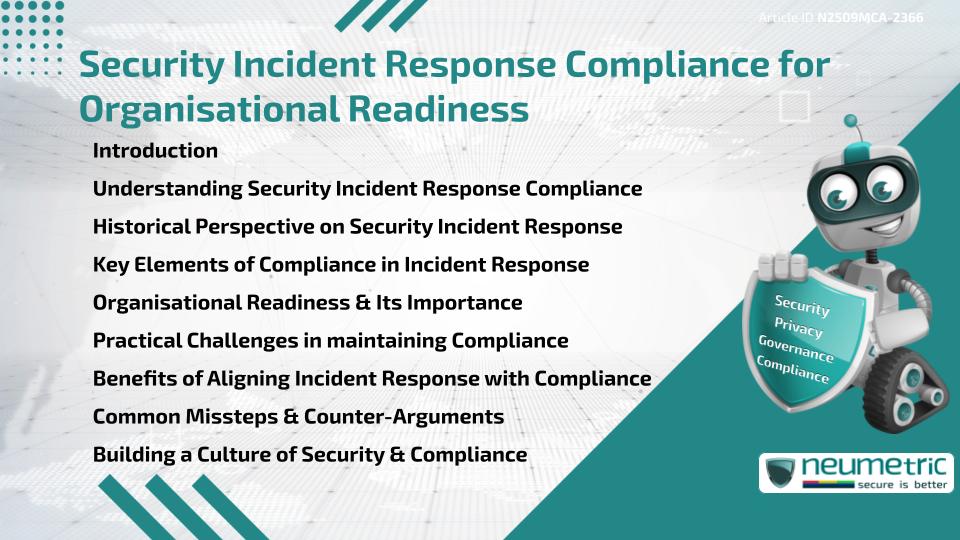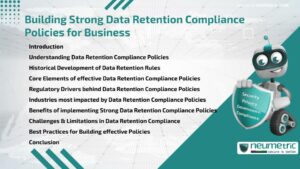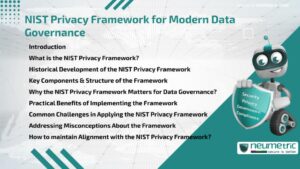Table of Contents
ToggleIntroduction
Security Incident Response compliance is a structured approach that ensures organisations follow regulatory, legal & best practice frameworks when addressing Security Incidents. It provides a Roadmap to handle Incidents efficiently while avoiding legal liabilities, Financial penalties & reputational damage. Organisational readiness in this context means being equipped with the processes, tools & trained personnel to respond effectively to any Threat. This article explores the history, key elements, benefits, challenges & common missteps related to Security Incident Response Compliance.
Understanding Security Incident Response Compliance
Security Incident Response compliance refers to adhering to Standards, Policies & Regulations that guide how Incidents should be detected, reported & resolved. Frameworks such as the National Institute of Standards & Technology [NIST] Cybersecurity Framework & International Organisation for Standardisation [ISO] 27001 serve as benchmarks. Compliance ensures organisations not only respond to Incidents but also meet legal requirements that safeguard Sensitive Information & foster trust among Stakeholders.
Historical Perspective on Security Incident Response
The idea of structured Incident Response emerged in the 1980s when computer networks first became targets of malicious actors. Early guidelines focused primarily on technical recovery. Over time, regulatory bodies & industries developed frameworks that combined technical & compliance measures. Today, regulations like the General Data Protection Regulation [GDPR] and the Health Insurance Portability & Accountability Act [HIPAA] mandate specific reporting & data handling processes during Incidents, demonstrating how compliance evolved alongside technological growth.
Key Elements of Compliance in Incident Response
To achieve Security Incident Response Compliance, organisations must integrate several elements:
- Detection & Monitoring: Systems must identify suspicious activities promptly.
- Reporting Procedures: Timely reporting to internal Stakeholders & regulators is mandatory.
- Documentation: Incident logs & Evidence collection ensure transparency.
- Recovery & Remediation: Compliance requires well-documented recovery steps.
- Review & Lessons Learned: Post-Incident reviews help refine Response Strategies.
These elements create a cycle of Continuous Improvement, making compliance a proactive measure rather than a reactive one.
Organisational Readiness & Its Importance
Organisational readiness is the ability to respond quickly & effectively to Security Incidents. It includes having an Incident Response team, conducting regular drills & updating Policies in line with evolving regulations. Without readiness, compliance efforts remain theoretical. For example, having Policies without trained personnel or functioning tools results in delayed responses, non-compliance & increased damage.
Practical Challenges in maintaining Compliance
Despite its importance, maintaining Security Incident Response Compliance is challenging. Resource constraints, lack of skilled personnel & evolving regulatory landscapes complicate readiness efforts. Small organisations often struggle to implement robust frameworks due to cost. Additionally, conflicting global compliance standards may lead to confusion. These challenges highlight the need for tailored solutions that fit an organisation’s size, industry & regulatory environment.
Benefits of Aligning Incident Response with Compliance
When organisations align Incident Response with compliance, they gain multiple benefits:
- Reduced Legal Risk: Adherence to regulations prevents costly lawsuits & fines.
- Enhanced Reputation: Clients & Partners trust compliant organisations more.
- Operational Efficiency: Streamlined processes save time & resources.
- Knowledge Retention: Documented procedures preserve institutional knowledge.
Thus, compliance is not only about avoiding penalties but also about building resilience.
Common Missteps & Counter-Arguments
Some organisations view compliance as a box-ticking exercise rather than a security enhancer. This perspective can lead to minimal effort that meets regulations on paper but fails in practice. Others argue that compliance frameworks are too rigid & do not account for unique industry needs. While these concerns have merit, they overlook the adaptability of most frameworks, which often allow for Risk-based approaches.
Building a Culture of Security & Compliance
For Security Incident Response Compliance to succeed, it must become part of organisational culture. This requires leadership support, ongoing Employee Training & integration of compliance into everyday operations. By fostering awareness & accountability, organisations transform compliance from a regulatory burden into a strategic asset that strengthens resilience.
Takeaways
- Security Incident Response compliance ensures legal, regulatory & ethical handling of Security Incidents.
- Organisational readiness is essential for compliance to be effective.
- Frameworks like NIST & ISO 27001 offer valuable guidelines.
- Challenges include resource limitations & varying global regulations.
- Viewing compliance as a cultural asset rather than a burden enhances resilience.
FAQ
What is Security Incident Response Compliance?
It is the practice of following regulatory, legal & Industry Standards when managing Security Incidents to ensure accountability & trust.
Why is organisational readiness important in compliance?
Without readiness, compliance remains theoretical. Trained staff, tools & processes ensure Policies work in practice.
Which Frameworks support Security Incident Response Compliance?
Frameworks like NIST Cybersecurity Framework, ISO 27001, GDPR & HIPAA provide standards for compliance.
What are the common challenges in maintaining compliance?
Challenges include resource constraints, evolving regulations & a lack of skilled personnel.
How does compliance benefit organisations beyond avoiding penalties?
It enhances reputation, improves efficiency & builds resilience through structured Incident management.
Is Compliance the same as Security?
No, Compliance ensures adherence to Regulations while Security focuses on protecting Assets. Both complement each other.
What mistakes do organisations often make with Compliance?
Common mistakes include treating Compliance as a checkbox exercise & failing to integrate it into daily practices.
How can organisations build a culture of Compliance?
Leadership commitment, Continuous Training & embedding compliance in daily operations foster a strong compliance culture.
References
- NIST Cybersecurity Framework
- ISO 27001 Information Security
- European Commission GDPR Overview
- HIPAA Journal – HIPAA Compliance
Need help for Security, Privacy, Governance & VAPT?
Neumetric provides organisations the necessary help to achieve their Cybersecurity, Compliance, Governance, Privacy, Certifications & Pentesting needs.
Organisations & Businesses, specifically those which provide SaaS & AI Solutions in the Fintech, BFSI & other regulated sectors, usually need a Cybersecurity Partner for meeting & maintaining the ongoing Security & Privacy needs & requirements of their Enterprise Clients & Privacy conscious Customers.
SOC 2, ISO 27001, ISO 42001, NIST, HIPAA, HECVAT, EU GDPR are some of the Frameworks that are served by Fusion – a SaaS, multimodular, multitenant, centralised, automated, Cybersecurity & Compliance Management system.
Neumetric also provides Expert Services for technical security which covers VAPT for Web Applications, APIs, iOS & Android Mobile Apps, Security Testing for AWS & other Cloud Environments & Cloud Infrastructure & other similar scopes.
Reach out to us by Email or filling out the Contact Form…





